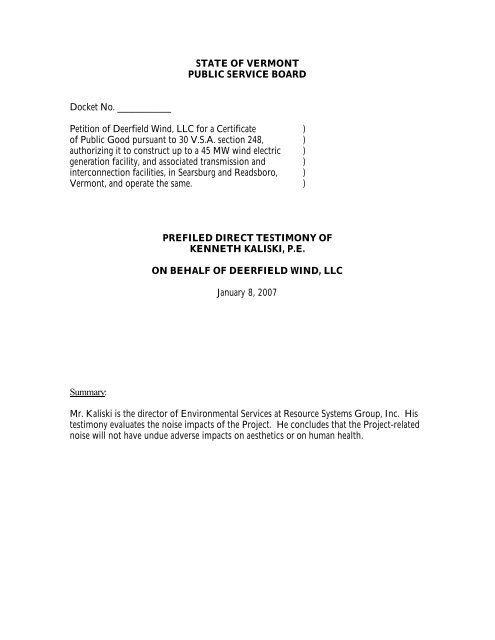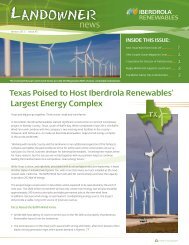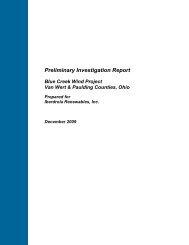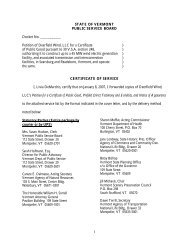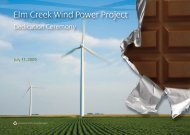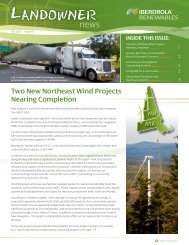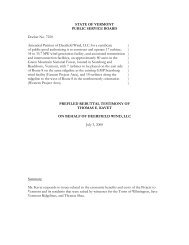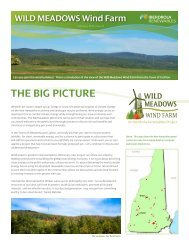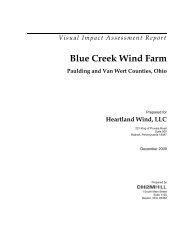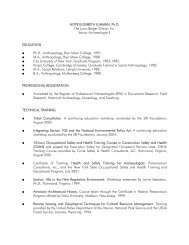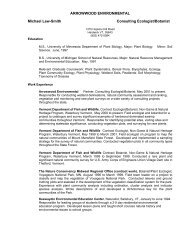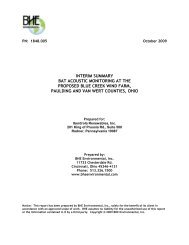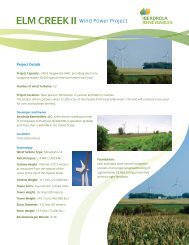Kaliski Prefiled-1.02.06 FINAL - Vermont Public Service Board ...
Kaliski Prefiled-1.02.06 FINAL - Vermont Public Service Board ...
Kaliski Prefiled-1.02.06 FINAL - Vermont Public Service Board ...
You also want an ePaper? Increase the reach of your titles
YUMPU automatically turns print PDFs into web optimized ePapers that Google loves.
STATE OF VERMONT<br />
PUBLIC SERVICE BOARD<br />
Docket No. ___________<br />
Petition of Deerfield Wind, LLC for a Certificate )<br />
of <strong>Public</strong> Good pursuant to 30 V.S.A. section 248, )<br />
authorizing it to construct up to a 45 MW wind electric )<br />
generation facility, and associated transmission and )<br />
interconnection facilities, in Searsburg and Readsboro, )<br />
<strong>Vermont</strong>, and operate the same. )<br />
PREFILED DIRECT TESTIMONY OF<br />
KENNETH KALISKI, P.E.<br />
ON BEHALF OF DEERFIELD WIND, LLC<br />
January 8, 2007<br />
Summary:<br />
Mr. <strong>Kaliski</strong> is the director of Environmental <strong>Service</strong>s at Resource Systems Group, Inc. His<br />
testimony evaluates the noise impacts of the Project. He concludes that the Project-related<br />
noise will not have undue adverse impacts on aesthetics or on human health.
Docket No. _______<br />
<strong>Prefiled</strong> Direct Testimony of Kenneth <strong>Kaliski</strong><br />
January 8, 2007<br />
Page 1 of 12<br />
1<br />
2<br />
3<br />
Q. Please state your name and occupation.<br />
Response. My name is Kenneth <strong>Kaliski</strong>. I am the Director of Environmental<br />
<strong>Service</strong>s at Resource Systems Group, Inc. of White River Junction, <strong>Vermont</strong>.<br />
4<br />
5<br />
6<br />
7<br />
8<br />
9<br />
10<br />
11<br />
12<br />
13<br />
14<br />
15<br />
16<br />
17<br />
18<br />
19<br />
20<br />
21<br />
22<br />
Q. Please describe your qualifications and experience.<br />
Response. I have a BA in Biology and Environmental Studies from Dartmouth<br />
College and a BE in Engineering from the Thayer School of Engineering at<br />
Dartmouth College. My educational experience includes coursework in sound level<br />
monitoring, noise control engineering, active noise control, indoor and outdoor<br />
acoustical modeling, vibration control, sound level meter design, and the physics and<br />
mathematics involving sound and its propagation.<br />
I have worked at Resource Systems Group since 1986, and serve on its <strong>Board</strong><br />
of Directors. Resource Systems Group is a member of the National Council of<br />
Acoustical Consultants.<br />
I have worked with the noise impacts of wind projects for over ten years.<br />
These projects include a review of the proposed Boundary Region project in Maine,<br />
the Searsburg project in Southern <strong>Vermont</strong>, a review of the Sheffield <strong>Vermont</strong><br />
project, and the Hoosick and Brodie Mountain projects, both in Western<br />
Massachusetts. My division of the company has also worked in other aspects<br />
associated with wind turbines, including air emissions offsets including Highland<br />
County, West Virginia, Reddington Wind Project in Maine, and East Haven in<br />
<strong>Vermont</strong>.
Docket No. _______<br />
<strong>Prefiled</strong> Direct Testimony of Kenneth <strong>Kaliski</strong><br />
January 8, 2007<br />
Page 2 of 12<br />
1<br />
2<br />
3<br />
4<br />
5<br />
6<br />
7<br />
I am a licensed professional engineer in the States of <strong>Vermont</strong> and New<br />
Hampshire. I am <strong>Board</strong> Certified through the Institute of Noise Control Engineering.<br />
I am a member of the Acoustical Society of America, the Air and Waste Management<br />
Association, the Institute of Transportation Engineers, and I am a Qualified<br />
Environmental Professional as Certified through the Institute of Environmental<br />
Practice. I hold a patent for an environmental noise monitoring system.<br />
My resume is attached as Exhibit DFLD-KK-1.<br />
8<br />
9<br />
10<br />
11<br />
12<br />
13<br />
14<br />
15<br />
16<br />
17<br />
18<br />
Q. Have you previously testified before the <strong>Public</strong> <strong>Service</strong> <strong>Board</strong> or in other<br />
judicial or administrative proceedings?<br />
Response. In my 20 years with Resource Systems Group, I have given testimony<br />
before all of <strong>Vermont</strong>'s nine District Commissions and the Environmental <strong>Board</strong><br />
regarding noise, traffic, air, and related impacts. Some of the most relevant<br />
Environmental <strong>Board</strong> cases where I have evaluated potential impacts from noise<br />
include John and Joyce Belter, Barre Granite Quarries, Black River Rod and Gun<br />
Club, Hannaford, John Russell Corp., McLean, and Alpine Stone. In addition, I<br />
provided testimony in the Section 248 proceeding for the Green Mountain Power<br />
Searsburg wind project and Velco’s Northwest Reliability Project.<br />
19<br />
20<br />
21<br />
22<br />
Q. What is the purpose of your testimony?<br />
Response. I will describe the results of our analysis evaluating the noise impacts of<br />
the proposed Deerfield Wind Project.<br />
23
Docket No. _______<br />
<strong>Prefiled</strong> Direct Testimony of Kenneth <strong>Kaliski</strong><br />
January 8, 2007<br />
Page 3 of 12<br />
1<br />
2<br />
3<br />
4<br />
5<br />
Q. Please summarize the investigations you conducted regarding the Project.<br />
Response. We conducted background noise monitoring at seven sites around the<br />
area. We then modeled sound levels from the proposed wind turbines in a 12,900<br />
acre area around the site. We compared these projected sound levels to relevant<br />
noise guidelines and standards.<br />
6<br />
7<br />
8<br />
9<br />
10<br />
11<br />
12<br />
13<br />
14<br />
15<br />
16<br />
17<br />
18<br />
19<br />
20<br />
21<br />
Q. Can you give a primer on sound and how it is modeled?<br />
Response. Yes. Exhibit DFLD-KK-2 defines “noise;” explains how sound<br />
propagates, describes the decibel scale, and gives a summary of how sound is<br />
attenuated by various factors.<br />
In general terms, sound attenuates over distance through the actions of<br />
geometric spreading, atmospheric absorption, meteorological effects, ground<br />
absorption, and intervening terrain, barriers, and vegetation.<br />
• The attenuation due to geometric spreading is about 6 dB for every doubling of<br />
distance over soft ground.<br />
• Air absorbs sound. The amount of absorption is dependent upon frequency,<br />
temperature, and humidity. Low frequencies are absorbed very little, while very<br />
high frequencies can be attenuated significantly over as little as 100 meters. Our<br />
modeling uses the ISO 9613-1 standard to calculate atmospheric absorption, and<br />
assumes the most conservative temperature and humidity condition (that is, for<br />
the least attenuation).
Docket No. _______<br />
<strong>Prefiled</strong> Direct Testimony of Kenneth <strong>Kaliski</strong><br />
January 8, 2007<br />
Page 4 of 12<br />
1<br />
2<br />
3<br />
4<br />
5<br />
6<br />
7<br />
8<br />
9<br />
10<br />
11<br />
12<br />
13<br />
• Temperature and wind gradients can affect sound propagation by bending sound<br />
either toward the ground or sky. Our modeling assumes a moderate nighttime<br />
inversion with winds blowing from each source to each receiver, simultaneously.<br />
• Intervening terrain will block the line of sight and thus reduce noise to the<br />
receiver. In this case, the turbines are up high enough so that there are only a few<br />
instances of receivers where the terrain blocks the noise from the wind turbines.<br />
Our modeling takes this into account automatically by integrating digital<br />
elevation data from the US Geological Survey.<br />
• Forest cover will reduce sound so long as it is dense enough to block the line of<br />
sight between the source and the receiver. It is not possible to conduct field<br />
checks of the line of sight over the large expanse of land evaluated for this<br />
project. Thus, we were conservative and assumed that there is no forest cover in<br />
the study area.<br />
14<br />
15<br />
16<br />
17<br />
18<br />
19<br />
20<br />
21<br />
22<br />
23<br />
Q. In your opinion, what noise standard should be applied at the nearest<br />
residences?<br />
Response. Neither Searsburg nor Readsboro has a quantitative community noise<br />
standard. In addition, there are no federal or state regulatory standards that apply to<br />
this project. The applicable standard under Section 248 is that the Project should not<br />
have an undue adverse effect on the aesthetics of the area. Therefore, to consider<br />
what is a reasonable level of noise, we must evaluate other standards and guidelines<br />
that are used elsewhere. Some of those standards include:<br />
• The US EPA Protective Noise Level Guideline
Docket No. _______<br />
<strong>Prefiled</strong> Direct Testimony of Kenneth <strong>Kaliski</strong><br />
January 8, 2007<br />
Page 5 of 12<br />
1<br />
2<br />
3<br />
4<br />
5<br />
6<br />
7<br />
8<br />
9<br />
10<br />
11<br />
12<br />
13<br />
14<br />
15<br />
16<br />
17<br />
18<br />
19<br />
20<br />
21<br />
22<br />
• The World Health Organization Suggested Community Noise Criteria<br />
• Bureau of Land Management Programmatic Environmental Impact<br />
Statement on Wind Energy Development<br />
The US EPA Protective Noise Level Guideline was established to determine<br />
a sound level that protects the public health and welfare with an adequate margin of<br />
safety. It is not a standard and is not meant to be applied as a standard. For most<br />
residential areas, the Protective Level is 55 dBA Ldn. The Ldn is day-night average<br />
sound level, with sounds during the night weighted by +10 dB.<br />
The Bureau of Land Management has developed a Programmatic<br />
Environmental Impact Statement (PEIS) on Wind Energy Development on BLM<br />
Lands in the Western United States. The PEIS discusses guidelines on citing wind<br />
turbines and refers to the EPA guideline of 55 dB Ldn: “The EPA guideline<br />
recommends an Ldn of 55 dB(A) to protect the public from the effect of broadband<br />
environmental noise in typically quiet outdoor and residential areas…. This level is<br />
not a regulatory goal but is ‘intentionally conservative to protect the most sensitive<br />
portion of the American population with an additional margin of safety.’”<br />
The World Health Organization’s “Guidelines for Community Noise”<br />
suggests noise criteria based on the most recent scientific research on noise effects.<br />
The Guidelines, published in 1999, recommend a limit of 50 dBA, averaged over the<br />
day to protect against moderate annoyance, and 45 dBA, averaged over the night to<br />
protect against sleep disturbance.<br />
In summary, the noise guidelines discussed above are:
Docket No. _______<br />
<strong>Prefiled</strong> Direct Testimony of Kenneth <strong>Kaliski</strong><br />
January 8, 2007<br />
Page 6 of 12<br />
Source<br />
Criteria<br />
US EPA Protective Noise Level 55 dB Ldn (or roughly 55 dBA during the day and 45<br />
dBA during the night)<br />
Bureau of Land Management<br />
World Health Organization<br />
55 dB Ldn<br />
50 dBA average during the day and 45 dBA average<br />
during the night<br />
1<br />
2<br />
3<br />
4<br />
5<br />
6<br />
7<br />
8<br />
9<br />
10<br />
11<br />
12<br />
Given the scientific evidence regarding sleep disturbance and other impacts<br />
that were reviewed by WHO, we propose that the Project should meet a standard of<br />
45 dBA Leq (night) averaged over the entire night and 50 dBA Leq (day) averaged<br />
over the remainder of the day. This is equivalent to a day-night average level of 52<br />
dB Ldn. This would be applied to areas of frequent human use during the summer<br />
months, including homes, yards, and porches. This would not apply to areas that<br />
have transient uses such as driveways, trails, and parking areas. This standard is more<br />
stringent than all of the federal standards mentioned above and is below the level<br />
that can cause hearing impairment and activity interference. This noise limit is both<br />
protective of human health and prevents any quality-of-life concerns, i.e., would not<br />
result in an undue adverse effect to the aesthetics of the area<br />
13<br />
14<br />
15<br />
16<br />
Q. Did you prepare an analysis of noise levels from the proposed wind turbines?<br />
Response. Yes. A detailed report showing our analysis is found in Exhibit DFLD-<br />
KK-3. That report describes background noise monitoring, modeling of the noise
Docket No. _______<br />
<strong>Prefiled</strong> Direct Testimony of Kenneth <strong>Kaliski</strong><br />
January 8, 2007<br />
Page 7 of 12<br />
1<br />
2<br />
from both the existing Searsburg project and the proposed project, and<br />
recommendations for mitigation.<br />
3<br />
4<br />
5<br />
6<br />
7<br />
8<br />
9<br />
10<br />
11<br />
12<br />
13<br />
14<br />
15<br />
16<br />
17<br />
Q. Based on your analysis, what are the forecasted sound levels at the closest<br />
homes?<br />
Response. Modeling of turbine noise was conducted using the standards set forth in<br />
ISO 9613-2, “Attenuation of Sound during Propagation Outdoors,” as implemented<br />
in the Cadna A software program. The ISO standard defines a methodology for<br />
predicting sound levels at distant receivers for meteorological conditions favorable to<br />
propagation. That is, during moderate nighttime inversions with winds blowing from<br />
the source to the receiver.<br />
The highest modeled sound level at a residence from the proposed Deerfield<br />
wind turbine strings is 41 dBA. This level would occur at the first two homes to the<br />
north of the cemetery adjacent to the Searsburg access road, which are approximately<br />
2,600 feet from the nearest proposed turbine site. At all other homes, sound levels<br />
would be less than 40 dBA, even when combined with the background sound<br />
contributed by the existing Searsburg turbines.<br />
18<br />
19<br />
20<br />
21<br />
22<br />
23<br />
Q. How do these sound levels compare with existing background levels at the<br />
closest receptors?<br />
Response. We measured background sound levels at seven locations around the<br />
proposed wind turbines. At representative locations along VT 8 and VT 9 where<br />
residences are located, average hourly sound levels ranged from 40 dBA at night to
Docket No. _______<br />
<strong>Prefiled</strong> Direct Testimony of Kenneth <strong>Kaliski</strong><br />
January 8, 2007<br />
Page 8 of 12<br />
1<br />
2<br />
3<br />
4<br />
5<br />
6<br />
60 dBA during the day. The sound levels were dependent on the diurnal pattern of<br />
traffic and background wind speed.<br />
The sound levels from the Deerfield Project will increase overall background<br />
noise (inclusive of background traffic) by less than 3 dBA at all residences. For<br />
comparison, the VTrans noise policy considers the “Effects of Increase” of 3 dB to<br />
be “None”.<br />
7<br />
8<br />
9<br />
10<br />
11<br />
12<br />
13<br />
14<br />
15<br />
16<br />
17<br />
18<br />
19<br />
20<br />
21<br />
22<br />
Q. Describe the mitigating effects of vegetation, ground absorption, topography,<br />
and wind.<br />
Response. Given the fact that the wind turbines are elevated significantly above the<br />
surrounding terrain, and that the turbines would operate during the winter when<br />
deciduous trees are bare, we did not assume that there would be any sound level<br />
reductions due to foliage.<br />
While we assumed that the foliage would not block the line of sight from any<br />
receiver to the wind turbines, we did assume that the ground along the entire area of<br />
the study is “porous” and thus would absorb some sound. The amount of absorption<br />
is factored in as part of the ISO 9613-2 algorithm.<br />
Topography generally has the greatest impact on sound propagation. The<br />
rolling nature of terrain can block the transmission path of the sound and reduce its<br />
level. Given the fact that the turbines are elevated on the highest ridges in the area,<br />
the amount of terrain reduction is minimized, but still taken into account by the<br />
model.
Docket No. _______<br />
<strong>Prefiled</strong> Direct Testimony of Kenneth <strong>Kaliski</strong><br />
January 8, 2007<br />
Page 9 of 12<br />
1<br />
2<br />
3<br />
4<br />
5<br />
6<br />
7<br />
8<br />
Wind has a complicated impact on sound levels. First, wind gradients can<br />
increase downwind propagation and decrease upwind propagation. Wind also affects<br />
metrological stability. The most stable nighttime conditions, which improve sound<br />
propagation, are under light or no winds, when the turbines would operate less.<br />
Third, wind affects the sound power of the wind turbine. Under higher wind speeds,<br />
the turbine generates more sound. Finally, higher wind speeds create higher<br />
background noise. This can mask the sound levels from the wind turbines, especially<br />
for ridgeline winds above 20 mph.<br />
9<br />
10<br />
11<br />
12<br />
13<br />
Q. Does the Project meet the standards outlined above?<br />
Response. Yes. The Project will not cause an exceedance of the noise standards at<br />
any of the residences (although it should be noted that for some of the residences,<br />
those noise standards may already be exceeded due to traffic-related noise).<br />
14<br />
15<br />
16<br />
17<br />
18<br />
19<br />
20<br />
21<br />
22<br />
Q. Did you conduct any other modeling analyses to further confirm this<br />
conclusion?<br />
Response. Yes. To evaluate the likelihood of sound levels exceeding a nighttime<br />
sleep disturbance level of 45 dBA Leq(8), we obtained one year of hourly wind speed<br />
and wind direction data from the ridgetop meteorological towers in Searsburg. We<br />
used this data to calculate stability class, and adjusted the sound output from the<br />
wind turbine based on the actual wind speed and assuming a ±2 dB confidence<br />
interval about the rated sound power level. Finally, we estimated the sound level at
Docket No. _______<br />
<strong>Prefiled</strong> Direct Testimony of Kenneth <strong>Kaliski</strong><br />
January 8, 2007<br />
Page 10 of 12<br />
1<br />
2<br />
3<br />
4<br />
5<br />
6<br />
7<br />
8<br />
9<br />
10<br />
11<br />
12<br />
13<br />
14<br />
this worst-case home for each hour of the year. Assuming these conditions, our<br />
results show:<br />
1) With the proposed Deerfield turbines operating only, there would be<br />
no hours of the year that exceed 45 dBA.<br />
2) With the combined operation of Deerfield and GMP/Searsburg, there<br />
would be a 99% probability that any hour would be at or below 45<br />
dBA.<br />
3) Of the hours that would exceed 45 dBA, none would occur during<br />
warm-weather months (May to September).<br />
4) With the combined operation, there would be no period during which<br />
the average 8-hour nighttime sound level would exceed 45 dBA.<br />
This analysis confirms that there is a very high probability that the 45 dBA<br />
Leq(8) standard will not be exceeded. In fact, under the above scenario, there were no<br />
periods in which the 45 dBA Leq(8) standard was exceeded.<br />
15<br />
16<br />
17<br />
18<br />
19<br />
Q. Will low frequency sound from the wind turbines create annoyance?<br />
Response. No. At the closest home, our models show that noise from the turbines<br />
below 31.5 Hz will be below the threshold of human hearing and noise at the 63 Hz<br />
octave band is well below levels that can create sound-induced building vibrations.<br />
20<br />
21<br />
22<br />
23<br />
Q. What will be the impacts of construction?<br />
Response. Most of the construction will take place at least 800 m (2,600 feet) away<br />
from the nearest residence. At this distance, the loudest pieces of equipment would
Docket No. _______<br />
<strong>Prefiled</strong> Direct Testimony of Kenneth <strong>Kaliski</strong><br />
January 8, 2007<br />
Page 11 of 12<br />
1<br />
2<br />
3<br />
4<br />
be a rock drill and wood chipper at 54 dBA and 58 dBA, respectively. The presence<br />
of dense vegetation is likely to reduce the levels by another roughly 10 dBA. Due to<br />
the setbacks involved and the limited duration of the activities, construction noise<br />
should not pose undue quality of life concerns.<br />
5<br />
6<br />
7<br />
8<br />
9<br />
10<br />
11<br />
12<br />
13<br />
14<br />
15<br />
16<br />
17<br />
18<br />
19<br />
20<br />
21<br />
Q. Are there other sources of operational noise besides the wind turbines?<br />
Response. There may be a transformer at the base of each turbine, similar to those at<br />
the Searsburg site. These transformers are not readily audible offsite.<br />
At the existing GMP substation or at a new substation to the northwest of<br />
the project area, there will be another 34.5 kV/69 kV transformer installed. This<br />
transformer will be designed to meet a noise level of no more than 45 dBA at the<br />
nearest residence.<br />
The 34.9 kV and 69 kV transmission lines associated with this project do not<br />
generate any significant noise and are likely to be inaudible. Noise from transmission<br />
lines is generally audible under certain conditions for line voltages at and above 500<br />
kV, which is well above what is proposed for Deerfield.<br />
The Project expects roughly two vehicle round trips each day to the Eastern<br />
and two to the Western Project Areas for maintenance and operations. The site will<br />
be accessed via a pickup truck or off-road vehicle in adverse conditions. This level of<br />
increased traffic will not create any adverse sound impacts especially considering the<br />
proximity of the nearest residences to state highways.<br />
22
Docket No. _______<br />
<strong>Prefiled</strong> Direct Testimony of Kenneth <strong>Kaliski</strong><br />
January 8, 2007<br />
Page 12 of 12<br />
1<br />
2<br />
3<br />
4<br />
5<br />
6<br />
7<br />
8<br />
9<br />
10<br />
11<br />
Q. What recommendations are you making to reduce the impacts of the<br />
Deerfield Wind Project?<br />
Response. Based on the above analysis, we recommend:<br />
1) Selecting turbines with a sound power level of 106 dBA or less or<br />
demonstrating that the final number and configuration of the turbines<br />
will not exceed 45 dBA, averaged over the night, at the nearest<br />
residence.<br />
2) Selecting wind turbines with no tonality or tonality within an<br />
acceptable level.<br />
3) Providing neighbors with a site supervisor to call so as to resolve<br />
noise complaints promptly.<br />
12<br />
13<br />
14<br />
15<br />
16<br />
17<br />
18<br />
19<br />
20<br />
21<br />
Q. With these measures, will the Project create undue adverse impacts on noise<br />
aesthetics?<br />
Response. No. The sound levels which will be generated by the Deerfield Wind<br />
Project will be below the commonly accepted WHO sleep disturbance noise standard<br />
and it can be constructed in such a way as to have no impact to health and no undue<br />
adverse impact on aesthetics.<br />
I would further note that I believe the Project could utilize a number of<br />
different configurations (in terms of the total number of turbines and turbine models)<br />
and still stay within the noise limits recommended above.<br />
22<br />
23<br />
Q. Does this conclude your testimony at this time?
Docket No. _______<br />
<strong>Prefiled</strong> Direct Testimony of Kenneth <strong>Kaliski</strong><br />
January 8, 2007<br />
Page 13 of 12<br />
1<br />
Response. Yes.


